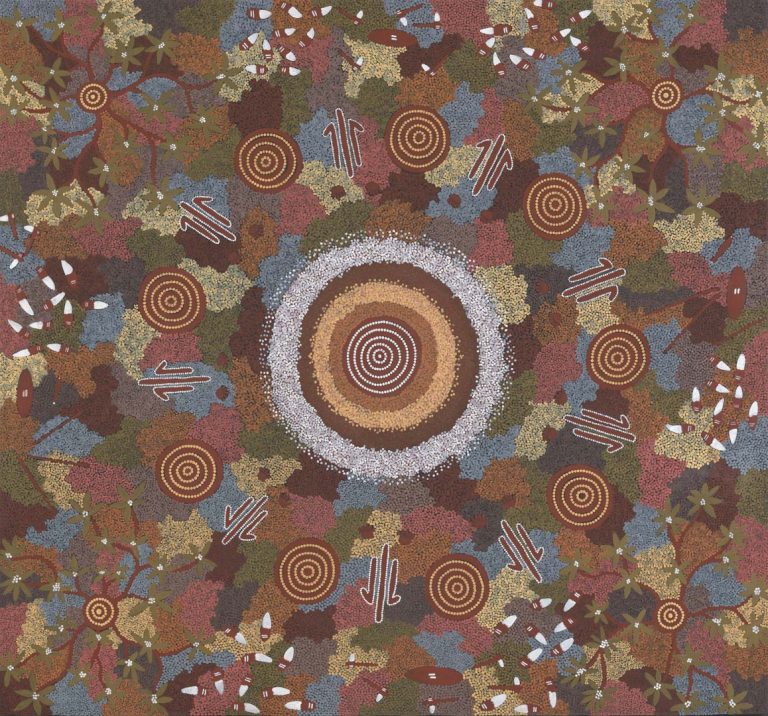We acknowledge the Traditional Owners of the land on which the Queensland Art Gallery | Gallery of Modern Art stands and recognise the creative contribution First Australians make to the art and culture of this country.

Kumantye Jagamara / Warlpiri/Luritja people / Australia c.1946—2020 / Kangaroo Story at Wantapi 1988 / Synthetic polymer paint on linen / 213 x 228cm / Gift of Robert Bleakley through the Queensland Art Gallery | Gallery of Modern Art Foundation 2017. Donated through the Australian Government’s Cultural Gifts Program / Collection: Queensland Art Gallery | Gallery of Modern Art / © Estate of Kumantje Jagamara
Kumantye JagamaraKangaroo Story at Wantapi 1988
Not Currently on Display
The tracks in this painting show an old kangaroo sitting looking at the kangaroo ‘milk guts’ which are depicted by the central circle. The roundels are the camps of the kangaroo ancestors whose spears, shields and stone implements are featured. The central section of the work, the large central circle, the smaller ones and the kangaroo tracks are designs used during the men’s ceremonies associated with the site of Wantampi, close to Mt Singleton. In each corner of the painting the artist has shown the Wild Fig Dreaming. The trees on which this fruit is found grow in the hills.1
Kangaroo Story at Wantapi is a classic work by Kumantye Jagamara, with great energy being generated through an intense field of almost camouflage pattern-like field of differently coloured dotted blocks packed against each other, jostling for attention across the picture plane.
On top of this background the narratives associated with the Kangaroo Story unfold through an arrangement of objects and icons used in both the narrative and the ceremonies commemorating and continuing this Dreaming. All of these elements are married in a near-perfect symmetry, a hallmark of Western Desert painting.
This large kangaroo dreaming painting is closely related to the Australian Parliament House forecourt mosaic Possum and Wallaby Dreaming 1986–87.
Endnotes:
1. Artist Statement, Papunya Tula Artists certificate.
Kumantye Jagamara OAM was one of the foremost champions of the Western Desert painting movement and a deeply respected Warlpiri/Luritja Elder and senior cultural leader of the broader Papunya community. He was a dynamic innovator of Papunya’s second wave of painters known for creating evocative new forms to portray his ancestral inheritance.
Born at Pikilyi (Vaughan Springs) in the Northern Territory, Kumantye lived a traditional life in his early years. As a young boy, he was taught sand, body and shield paintings by his grandfather. After initiation, he had a varied career – buffalo shooting, driving trucks, droving cattle, and in the military – before returning to Papunya, where he married Marjorie Napaltjarri in 1976. There, Kumantye observed the older artists painting for several years before he began painting for Papunya Tula Artists in 1983, guided by his uncle Jack Tjupurrula.
In both life and art, Kumantye held true to his jukurrpa: his Warlpiri law, its interconnected cultural knowledge system and dreamings. His Country, Pikilyi, is an important ceremonial site at the intersection of a number of the dreamings represented in his works – Possum, Snake, Two Kangaroos, Flying Ant and Yam – alongside lightning, rain, shields and sacred sites.
Discussion Questions
1. Look closely at the work. How many different shapes and colours can you see?
2. Can you see the sign for kangaroo in this painting? Look closely for groups of three line — the longest line in the middle represents the tail and the two hooked lines either side are the kangaroo’s legs. How many of these signs can you see?
Activities
1. Explore the concept of symmetry by creating a inkblot painting (also known as a squishie) of the face of your favourite animal. Fold a piece of paper in half, open it up and paint half of the face on one side, making sure that your image is as close to the fold as possible. While the paint is still wet, carefully press the blank side of your paper onto the final image and then peel back to reveal the other half.
2. Create an abstract collage using materials found around your school or home. Think about how you can use colour and composition to communicate meaning. Write a short artist statement explaining your work.